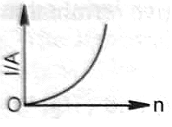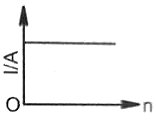The power generated across a uniform wire connected across a supply is H. If the wire is cut into n equal parts and all the parts are connected in parallel across the same supply, the total power generated in the wire is:
1.
2. n2H
3. nH
4.
When electric bulbs of the same power, but different marked voltage are connected in series across the power line, their brightness will be:
1. proportional to their marked voltage.
2. inversely proportional to their marked voltage.
3. proportional to the square of their marked voltage.
4. the same for all of them.
A battery consists of a variable number n of identical cells having internal resistance connected in series. The terminals of the battery are short-circuited and the current I measured. Which one of the graph below shows the relationship between I and n?
1. 
2. 
3.
4.
Three identical resistors are connected across a voltage source V so that one of them is in parallel with two others which are connected in series as shown. The power dissipated through the first one, compared to the power dissipated by each of the other two, is approximately:
1. the same
2. half as much
3. twice as much
4. four times as much
A metallic resistor is connected across a battery. If the number of collisions of free electrons with the lattice is somehow decreased in the resistor (for example cooling it), the current will:
1. Increase
2. Decrease
3. remain the same
4. become zero
A constant voltage is applied between the two ends of a uniform metallic wire. Some heat is developed in it. The heat developed doubles if:
| 1. | both the length and the radius of the wire are halved. |
| 2. | both the length and the radius of the wire are doubled. |
| 3. | the radius of the wire is doubled. |
| 4. | The length of the wire is doubled. |
In an electrical circuit containing a battery, the charge (assume positive) inside the battery:
1. always goes from the positive terminal to the negative terminal.
2. may go from the positive terminal to the negative terminal.
3. always goes from the negative terminal to the positive terminal.
4. does not move.
Two non-ideal batteries are connected in parallel. Consider the following statements:
(A) The equivalent EMF is smaller than either of the two EMFs.
(B) The equivalent internal resistance is smaller than either of the two internal resistances.
1. Both (A) and (B) are correct
2. (A) is correct and (B) is wrong
3. (B) is correct but (A) is wrong
4. Both (A) and (B) are wrong
In a balanced Wheatstone bridge, the current in the galvanometer is zero. It remains zero when:
[1] battery emf is increased.
[2] all resistances are increased by 10 ohms.
[3] all resistances are made five times.
[4] the battery and the galvanometer are interchanged.
1. Only [1] is correct
2. [1], [2] and [3] are correct
3. [1], [3] and [4] are correct
4. [1] and [3] are correct
When a battery is getting charged:
1. the voltage drop across its internal resistance is zero.
2. the terminal potential difference is less than its emf.
3. the terminal potential difference is more than its emf.
4. its terminal potential difference is zero.








